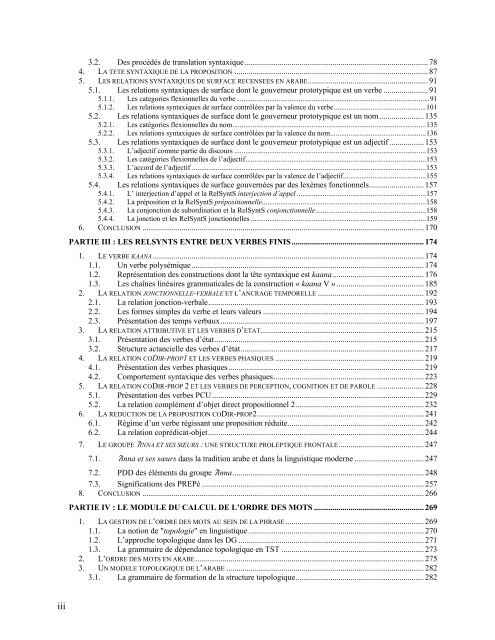une etude contrastive de l'arabe et du français dans une perspective ...
une etude contrastive de l'arabe et du français dans une perspective ...
une etude contrastive de l'arabe et du français dans une perspective ...
Create successful ePaper yourself
Turn your PDF publications into a flip-book with our unique Google optimized e-Paper software.
3.2. Des procédés <strong>de</strong> translation syntaxique..........................................................................................78<br />
4. LA TETE SYNTAXIQUE DE LA PROPOSITION ............................................................................................... 87<br />
5. LES RELATIONS SYNTAXIQUES DE SURFACE RECENSEES EN ARABE........................................................... 91<br />
5.1. Les relations syntaxiques <strong>de</strong> surface dont le gouverneur prototypique est un verbe ...................... 91<br />
5.1.1. Les categories flexionnelles <strong>du</strong> verbe.........................................................................................................91<br />
5.1.2. Les relations syntaxiques <strong>de</strong> surface contrôlées par la valence <strong>du</strong> verbe..................................................101<br />
5.2. Les relations syntaxiques <strong>de</strong> surface dont le gouverneur prototypique est un nom...................... 135<br />
5.2.1. Les catégories flexionnelles <strong>du</strong> nom.........................................................................................................135<br />
5.2.2. Les relations syntaxiques <strong>de</strong> surface contrôlées par la valence <strong>du</strong> nom....................................................136<br />
5.3. Les relations syntaxiques <strong>de</strong> surface dont le gouverneur prototypique est un adjectif ................. 153<br />
5.3.1. L’adjectif comme partie <strong>du</strong> discours ........................................................................................................153<br />
5.3.2. Les catégories flexionnelles <strong>de</strong> l’adjectif..................................................................................................153<br />
5.3.3. L’accord <strong>de</strong> l’adjectif ...............................................................................................................................153<br />
5.3.4. Les relations syntaxiques <strong>de</strong> surface contrôlées par la valence <strong>de</strong> l’adjectif.............................................155<br />
5.4. Les relations syntaxiques <strong>de</strong> surface gouvernées par <strong>de</strong>s lexèmes fonctionnels........................... 157<br />
5.4.1. L’ interjection d’appel <strong>et</strong> la RelSyntS interjection d’appel ......................................................................157<br />
5.4.2. La préposition <strong>et</strong> la RelSyntS prépositionnelle.........................................................................................158<br />
5.4.3. La conjonction <strong>de</strong> subordination <strong>et</strong> la RelSyntS conjonctionnelle............................................................158<br />
5.4.4. La jonction <strong>et</strong> les RelSyntS jonctionnelles ...............................................................................................159<br />
6. CONCLUSION .......................................................................................................................................... 170<br />
PARTIE III : LES RELSYNTS ENTRE DEUX VERBES FINIS ................................................................. 174<br />
1. LE VERBE KAANA ..................................................................................................................................... 174<br />
1.1. Un verbe polysémique.................................................................................................................. 174<br />
1.2. Représentation <strong>de</strong>s constructions dont la tête syntaxique est kaana............................................. 176<br />
1.3. Les chaînes linéaires grammaticales <strong>de</strong> la construction « kaana V »........................................... 185<br />
2. LA RELATION JONCTIONNELLE-VERBALE ET L’ANCRAGE TEMPORELLE .................................................... 192<br />
2.1. La relation jonction-verbale.......................................................................................................... 193<br />
2.2. Les formes simples <strong>du</strong> verbe <strong>et</strong> leurs valeurs ............................................................................... 194<br />
2.3. Présentation <strong>de</strong>s temps verbaux.................................................................................................... 197<br />
3. LA RELATION ATTRIBUTIVE ET LES VERBES D’ETAT................................................................................ 215<br />
3.1. Présentation <strong>de</strong>s verbes d’état....................................................................................................... 215<br />
3.2. Structure actancielle <strong>de</strong>s verbes d’état.......................................................................................... 217<br />
4. LA RELATION CODIR-PROP1 ET LES VERBES PHASIQUES ......................................................................... 219<br />
4.1. Présentation <strong>de</strong>s verbes phasiques ................................................................................................ 219<br />
4.2. Comportement syntaxique <strong>de</strong>s verbes phasiques.......................................................................... 223<br />
5. LA RELATION CODIR-PROP 2 ET LES VERBES DE PERCEPTION, COGNITION ET DE PAROLE ....................... 228<br />
5.1. Présentation <strong>de</strong>s verbes PCU........................................................................................................ 229<br />
5.2. La relation complément d’obj<strong>et</strong> direct propositionnel 2............................................................... 232<br />
6. LA REDUCTION DE LA PROPOSITION CODIR-PROP2.................................................................................. 241<br />
6.1. Régime d’un verbe régissant <strong>une</strong> proposition ré<strong>du</strong>ite................................................................... 242<br />
6.2. La relation coprédicat-obj<strong>et</strong>.......................................................................................................... 244<br />
7. LE GROUPE ʔINNA ET SES SŒURS : UNE STRUCTURE PROLEPTIQUE FRONTALE.......................................... 247<br />
7.1. ʔinna <strong>et</strong> ses sœurs <strong>dans</strong> la tradition arabe <strong>et</strong> <strong>dans</strong> la linguistique mo<strong>de</strong>rne .................................. 247<br />
7.2. PDD <strong>de</strong>s éléments <strong>du</strong> groupe ʔinna.............................................................................................. 248<br />
7.3. Significations <strong>de</strong>s PREPé ............................................................................................................. 257<br />
8. CONCLUSION .......................................................................................................................................... 266<br />
PARTIE IV : LE MODULE DU CALCUL DE L’ORDRE DES MOTS ...................................................... 269<br />
1. LA GESTION DE L’ORDRE DES MOTS AU SEIN DE LA PHRASE.................................................................... 269<br />
1.1. La notion <strong>de</strong> "topologie" en linguistique ...................................................................................... 270<br />
1.2. L’approche topologique <strong>dans</strong> les DG ........................................................................................... 271<br />
1.3. La grammaire <strong>de</strong> dépendance topologique en TST ...................................................................... 273<br />
2. L’ORDRE DES MOTS EN ARABE................................................................................................................ 275<br />
3. UN MODELE TOPOLOGIQUE DE L’ARABE ................................................................................................. 282<br />
3.1. La grammaire <strong>de</strong> formation <strong>de</strong> la structure topologique............................................................... 282<br />
iii

















